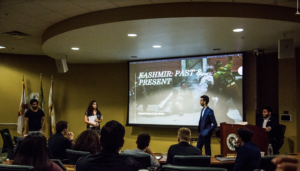‘Justice for Kashmir’ resolution sparks controversy

Tensions ran high at the Student Government (SG) Senate meeting Tuesday night after a long-debated resolution passed on the 72-year territorial conflict between India and Pakistan.
Articles 370 and 35A were removed from the Indian Constitution Aug. 5, which together revoked the autonomy of the disputed Kashmir territory. The articles were fundamental in providing Kashmir its own flag, laws and constitution.
Located in the region of the Himalayan and Karakoram mountains, Kashmir has been the center of much conflict between Pakistan and India since the partition of the Indian subcontinent in 1947, when both countries gained independence from Britain.
The Muslim-majority region of Kashmir shares borders with India, Pakistan and China. After the decision to revoke both articles, the Indian government imposed communication restrictions on Kashmir, which suspended telephone and internet service while implementing military curfews, according to the Washington Post.
The “Justice for Kashmir” resolution passed with 24 senators voting yes and 14 voting no.
It was not an easy decision for the Senate after more than three hours of contested debate.
Resolution author Sen. Noor Kantar and sponsors Khubaib Farooq and Monis Wazir presented a PowerPoint to the Senate explaining why they believe the conflict is a “human rights violation.”
The resolution says that SG condemns the “use of force by the Indian Army and paramilitary forces” and “the blanket ban on communication.”
Some Indian students in the Senate gallery said the resolution was “one-sided,” including President of the Students of India Association (SIA) Manushi Shah.
In an interview with The Oracle, Shah said she was disappointed with the outcome because she felt that the resolution was biased. She said there are other groups involved in the conflict, such as “Pakistan militant groups.”
“Yes, we are trying to address the human rights issue and the intent of the resolution, but it has not done justice in addressing all the parties involved in the human rights violation,” Shah said. “The Indian government is committing a human rights violation but they are not the only ones.”
Farooq said he understands that not everyone will be satisfied with the resolution and that it was only intended to represent one aspect of the conflict.
“There is no (ban) on the Chinese side or Pakistan side, people there are able to live their lives normally,” Farooq said in an interview with The Oracle. “On the Indian side, there are restrictions on communication.”
The Senate gallery was similarly divided by ideology, with students representing Pakistan sitting on one side and Indian representation on the other.
Of the 22 people in the gallery, nine spoke and discussed both sides during open forum. Students shared personal stories of the conflict, read aloud news articles about the current state of Kashmir and gave speeches about whether to support or oppose the resolution.
Senators expressed a similar difference of opinion.
Many of the disagreements came from the verbiage of the resolution, such as what exactly a “human rights violation” is.
Sen. Misha Patel proposed to change a line in the resolution to say “bans are being lifted in the Indian administered Kashmir to restore normalcy.”
However, 30 senators voted against the motion and 13 voted yes.
Landline phones have been restored in Kashmir, but many of the calls have not gone through, according to U.S. News and World Report.
SG Relation Chair Alliyah Edwards said to the Senate, “If you are going to change the language, make sure it is because it is going against what (the resolution) is saying, not because you don’t like it or think it’s factually incorrect.”
In a way to tame the back-and-forth discord, Senate President Salud Martinez made it a point to the senators that the resolution does not represent the entire conflict.
“There are multiple perspectives to different issues and you guys can write resolutions based on that,” Martinez said. “It’s hard to fit a world issue all into one page. And it’s hard to have everyone’s perspectives showcased.”
Shah said this is exactly what she has planned next. In an effort to “represent the Indian perspective,” she said SIA will work on drafting its own resolution.
“It is important that (SG) realizes that they are voted in by students who represent their best interest,” Shah said. “Many times, when we look at global issues, people do not realize it is extremely complex. You cannot take a small snapshot of the conflict and vote on something like this.”
Farooq said he is “relieved” that the resolution was passed because it has been continually discussed since it was first presented to the SG Relations Committee on Sept. 12.
“This was affecting a lot of people on campus — Pakistanis, Muslims and Hindu students,” Farooq said. “I am relieved that this has been addressed.”
Martinez recognized that there were students who were upset about the resolution’s passage and encouraged them to take action if they felt strongly about an issue.
“Whenever somebody writes a resolution, it’s a statement that they want to make,” Martinez said. “A resolution can have many sides.
“Just because one just showcases one perspective, it doesn’t mean that another one cannot be written from another perspective.”








